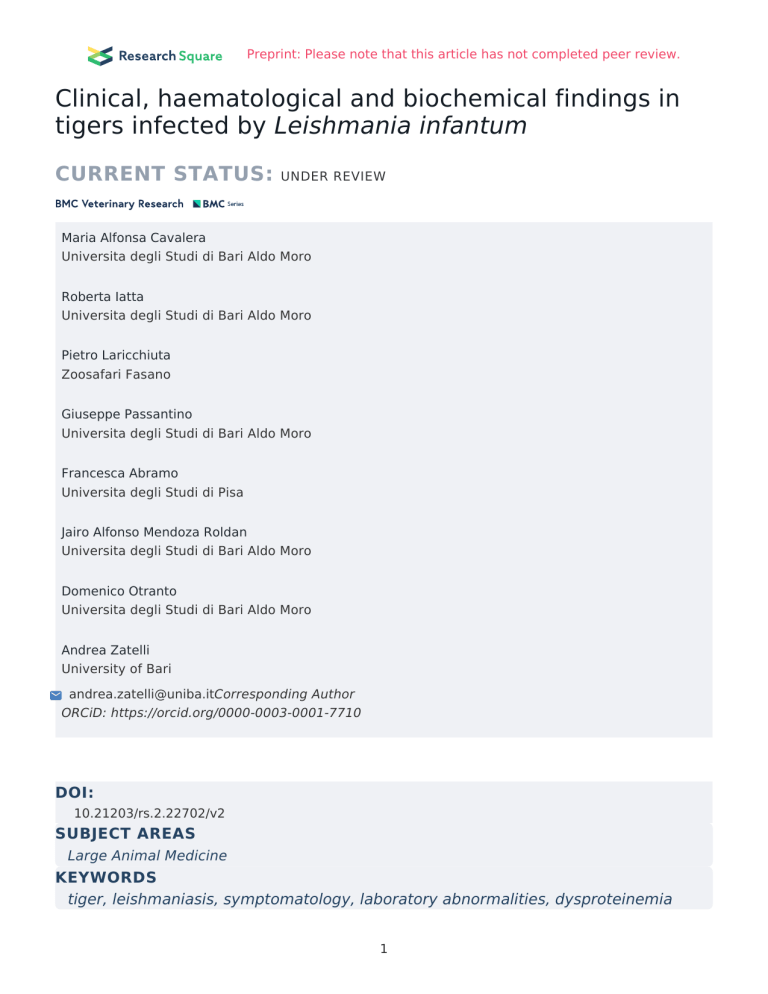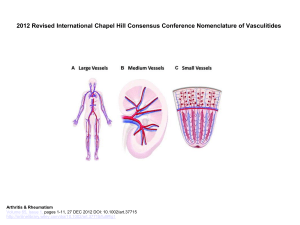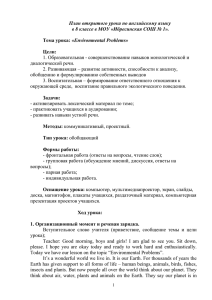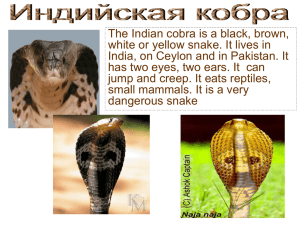Clinical, haematological and biochemical findings in tigers infected by Leishmania infantum
реклама

Preprint: Please note that this article has not completed peer review. Clinical, haematological and biochemical findings in tigers infected by Leishmania infantum CURRENT STATUS: UNDER REVIEW Maria Alfonsa Cavalera Universita degli Studi di Bari Aldo Moro Roberta Iatta Universita degli Studi di Bari Aldo Moro Pietro Laricchiuta Zoosafari Fasano Giuseppe Passantino Universita degli Studi di Bari Aldo Moro Francesca Abramo Universita degli Studi di Pisa Jairo Alfonso Mendoza Roldan Universita degli Studi di Bari Aldo Moro Domenico Otranto Universita degli Studi di Bari Aldo Moro Andrea Zatelli University of Bari [email protected] Author ORCiD: https://orcid.org/0000-0003-0001-7710 DOI: 10.21203/rs.2.22702/v2 SUBJECT AREAS Large Animal Medicine KEYWORDS tiger, leishmaniasis, symptomatology, laboratory abnormalities, dysproteinemia 1 Abstract Background A large number of animal species are susceptible to Leishmania infantum (Kinetoplastida, Trypanosomatidae) in endemic areas, including domestic and wild felids such as tigers (Panthera tigris). Knowledge on the infection of this endangered species is still at its infancy, and therefore this study aims to identify clinical presentation and clinicopathological findings of tigers naturally infected by L. infantum. Results Tigers either L. infantum-positive (group A) or -negative (group B) were apparently healthy or presented visceral leishmaniasis unrelated conditions, except for one animal in which a large nonhealing cutaneous lesion was observed. However, histological exam and immunohistochemistry carried out on the lesion excluded the presence of L. infantum amastigotes. Biochemical analysis showed that the average concentration of total proteins, globulins and haptoglobin were significantly higher (p<0.01, p=0.01 and p=0.02, respectively), while the albumin/globulin ratio significantly lower (p=0.05) in group A compared with group B. The biochemical alterations were partially confirmed by the serum protein electrophoresis results revealing a significant increase in the total protein value (p=0.01) and hypergammaglobulinemia (p=0.03) but an unmodified albumin/globulin ratio in group A. Conclusions In this study tigers infected by L. infantum have shown to be mainly asymptomatic. The absence of clinical signs may lead veterinarians to overlook leishmaniasis in animals kept in captivity. Therefore, diagnostic and screening tests as serology should be part of routinely surveillance programs to be performed on tigers in zoological gardens located in endemic areas. Though only few protein-related laboratory abnormalities were recorded in infected animals, they could provide diagnostic clues for a first suspicion of L. infantum infection in tigers. Indeed, considering the high risk of zoonotic transmission in heavily frequented environment as zoos, a prompt diagnosis of L. infantum infection is of pivotal importance. Introduction Leishmania infantum (Kinetoplastida, Trypanosomatidae) has been recognised as the main causative agent of canine leishmaniasis (CanL) (Ribeiro et al., 2018). This zoonotic sand fly-borne disease is one of the world’s most important neglected illnesses (WHO, 2018), though it is potentially fatal to 2 humans if left untreated (Vilas et al., 2014). Dogs are the main peridomestic reservoir host of the protozoa (Dantas-Torres et al., 2012), developing a chronic and multisystemic infection that may potentially involve any organ (Solano-Gallego et al., 2011). Consequently, CanL is characterized by a wide variety of non-specific clinical presentations ranging from asymptomatic infection to a severe fatal clinical disease, mainly depending on the host’s Th1/Th2 immune responsiveness (Paltrinieri et al., 2010; Hosein et al., 2017). The most common clinical manifestations of CanL due to L. infantum are skin lesions, lymphadenomegaly and weight loss (Paltrinieri et al., 2010; Meléndez-Lazo et al., 2018). In endemic areas, L. infantum is maintained by several mammal species in nature (Roque and Jansen, 2014) and the role of wildlife species (e.g., red fox, golden jackal, gray wolf, hare, black rat) has been suggested in a series of studies (Millan et al., 2014; Otranto et al., 2015). After being long regarded as resistant, cats have gain the interest of the scientific community as hosts of L. infantum, mainly in endemic areas (Iatta et al., 2019; Asfaram et al., 2019). Clinical signs compatible with feline leishmaniasis (FeL) include lymphadenomegaly, splenomegaly, weight loss, anorexia, as well as cutaneous, mucocutaneous and ocular lesions (Pennisi et al., 2018). However, the subclinical infection seems more common in endemic regions such as Mediterranean countries (Pennisi et al., 2018). The complex pathogenesis and the broad spectrum of clinical manifestations of visceral leishmaniasis (VL) in domestic animals make its diagnosis still challenging (Paltrinieri et al., 2016). Although the diagnosis of VL can be achieved by performing specific tests (i.e., serology, cytology, PCR, xenodiagnosis), laboratory abnormalities uncovered by routine haematology, clinical chemistry, or urinalysis may support the clinical suspicion of VL (Paltrinieri et al., 2016). For example, in CanL, nonregenerative normocytic normochromic anemia, leukogram changes (i.e. neutrophilia), trombocytopenia and dysproteinemia (i.e., hyperproteinemia, hyperglobulinemia, hypoalbuminemia, inversion in the albumin/globulin ratio) represent typical laboratory findings (Paltrinieri et al. 2016; Ribeiro et al., 2018; Maia and Persichetti, 2018). Renal dysfunction may be revealed by clinical chemistry (renal azotemia) and urinalysis (decreased urine specific gravity and proteinuria). Serum protein electrophoresis (SPE) is commonly used to identify a polyclonal gammopathy that may also 3 appear oligo-monoclonal, especially in dogs coinfected by other vector-borne pathogens (Paltrinieri et al. 2016; Ribeiro et al., 2018). Additionally, the increase of acute phase proteins (APP) and other markers of inflammation (i.e., C-reactive protein [CRP], serum amyloid A [SAA], haptoglobin [HPT], ferritin) have been frequently associated with CanL (Paltrinieri et al., 2016; Maia and Persichetti, 2018). In cats, scant information is available about laboratory abnormalities in L. infantum infected individuals as only the major body of literature is represented by case reports. Mild to severe normocytic normochromic non-regenerative anemia and hyperproteinemia with hypergammaglobulinemia are the main abnormalities reported (Soares et al., 2015; Pennisi et al., 2015) followed by moderate to severe pancytopenia in association with aplastic bone marrow, particularly in FIV-positive cats. Unlike in dogs, hypoalbuminemia is only occasionally detected in FeL (Pennisi et al., 2015). Recently, wild species of felids, including tigers (Panthera tigris), have been recognized as susceptible hosts to L. infantum in endemic areas (de Olivera et al., 2018; Tolentino et al., 2019). Considering that knowledge of the infection of this endangered species (IUCN 2015) is still at its infancy, data on clinical picture in tigers infected by L. infantum are missing. Thus, the aim of this study was to identify clinical presentation and clinicopathological findings of tigers naturally infected with L. infantum. Results Clinical findings Tigers (8 males and 12 females), individually identified by microchip, aged from 6 months to 11 years, weighed from 70 to 220 kg and showed a BCS=3 except for the tiger 4 (BCS=2) (Table 1). Animals from group A (i.e. L. infantum-positive animals) as well as those from group B (i.e L. infantumnegative animals) were apparently healthy or presented VL unrelated conditions, except for the tiger 1 in which a large (10 cm) non-healing cutaneous lesion was observed. After an incisional skin biopsy of the lesion, an histological exam has been performed revealing a chronic ulcerative dermatitis and vasculitis/perivasculitis with plasma cellular infiltrate. During the histological examination, no pathogens were detected. The absence of amastigotes was also confirmed by immunohistochemistry. 4 Haematological and biochemical findings Mean and median values of complete blood count (CBC) and biochemical parameters obtained from group A and B are statistically compared and reported in Tables 2 and 3, respectively. The SPE results are shown in Table 3. Data available on the Zoological Information Management System (ZIMS) from Species 360 (formerly the International Species Inventory System, ISIS) have been included, when available, as haematology and biochemistry reference values of the tigers (Tables 2, 3). Biochemical analysis showed that the average concentration of total proteins, globulins and haptoglobin were significantly higher (p<0.001, p=0.01 and p=0.02, respectively), while the albumin/globulin ratio significantly lower (p=0.05) in group A compared with group B. Urine samples were collected from 12 (i.e. n=6 L. infantum-positive tigers and n=6 L. infantum-negative tigers) out of 20 animals. Mean and median values of urine specific gravity (USG) and urine protein/creatinine ratio (UP/C) detected in group A and B are reported in Table 3. Discussion This study represents the first identification of clinical presentation and clinicopathological findings in L. infantum naturally infected tigers. These animals have shown to be asymptomatic considering the clinical pictures usually detected in CanL and FeL (Paltrinieri et al., 2010; Meléndez-Lazo et al., 2018; Pennisi et al., 2018). Although data on the pathogenesis of L. infantum infection in tigers are missing, it can be supposed that progression to illness could be associated with increasing antibody titres as it occurs in CanL and, likely, in FeL (Foglia Manzillo et al., 2013; Maroli et al., 2007). Indeed, out of 8 asymptomatic tigers positive at IFAT, 7 presented a low antibody titre (i.e., n=3 1:40, n=4 1:80). In this study, no statistically significant haematological differences were found between tigers of group A and B (Table 2). Similarly, haematological and biochemical parameters are usually not modified in L. infantum infected dogs with or without mild localized clinical signs but positive to direct diagnostic methods or presenting low-titre or none anti-Leishmania antibodies (Solano-Gallego et al., 2009; Paltrinieri et al., 2010; Maia and Persichetti, 2018). Conversely, a significant protein imbalance including hyperproteinemia, hyperglobulinemia and 5 decreased albumin/globulin ratio were detected in group A (Table 3). These abnormalities in the biochemistry panel can appear early during the onset of VL (Paltrinieri et al., 2016) being associated with disease progression (Maia and Persichetti, 2018) and represent a typical finding in CanL, as also described in cases of cats with FeL (Paltrinieri et al., 2016; Soares et al., 2015; Pennisi et al., 2013; 2015). In addition, no difference in the levels of albumin in the group A compared to group B was found, similarly to cats where hypoalbuminemia has been only occasionally detected (Pennisi et al., 2015). The biochemical alterations were partially confirmed by the SPE results revealing a significant increase in the total protein value (p=0.01) and a hypergammaglobulinemia (p=0.03) but an unmodified albumin/globulin ratio in group A (Table 3). Furthermore, even though a significant increase of α-2 globulins in group A (1.0 g/dL) compared to group B (0.7 g/dL) was not found, the value of this globulin in L. infantum-positive animals was moderately increased referred to the ZIMS reference parameter for tigers (0.53 g/dL) (Table 3). α-2 globulins includes most of the positive APP, as haptoglobin, which are powerful indicators of inflammation during CanL (Paltrinieri et al., 2016). Therefore, the lightly increased of α-2 globulins in group A can be explained by the significantly increase of the haptoglobin (p=0.02) detected in L. infantum-positive tigers (Table 3). The presence of renal disease in group A can be excluded considering the absence of alteration in renal function markers as the serum concentration of creatinine and BUN, the urine specific gravity and the urine protein/creatinine ratio (Table 3). These markers are useful to suspect severe/very severe CanL with renal involvement (Maia and Campino, 2018) causing a chronic kidney disease (CKD) that is a well-recognized condition potentially fatal for dogs affected by CanL (Paltrinieri et al., 2018). Though renal failure in association with FeL has been described, the exact role of L. infantum infection in the development of multiorgan injury with renal impairment has to be confirmed (Pennisi et al., 2015). Therefore, considering the lack of information on leishmaniasis in tigers, further studies are necessary to draw any conclusion on the potential non-involvement of the kidney in this new species. The clinicopathological picture of L. infantum-infected tigers emerging from the present study is 6 mainly characterized by a subclinical condition and few protein-related laboratory abnormalities, which highly supports the hypothesis on the potential role of tigers as alternative local reservoir of L. infantum. Similarly, this picture has been suggested also for cats, which presumably act as reservoir hosts at least in endemic areas of zoonotic VL (Pennisi et al., 2018; Asfaram et al., 2019; Iatta et al., 2019). Although laboratory abnormalities are usually aspecific in animals with VL (Paltrinieri et al., 2016), they can represent a wake-up call for veterinarians working with tigers in zoological parks where routine screening for VBDs as leishmaniasis is not frequent. Furthermore, performing laboratory tests could be essential in L. infantum-positive tigers which live in an endemic area, thus being at risk of infection (n=9/20, 45%). However, the potential limitation of the study consists of the impossibility of carrying out an in-depth clinical examination that would allow all clinical signs related to VL (e.g., splenomegaly) to be properly evaluated. Another limit of the study could be represented by the absence of information on potential other diseases affecting tigers which can influence the laboratory parameters. Finally, the available haematological and biochemical reference values in tigers are limited and obtained from a small population size not properly divided considering age, sex and sampling season (Padmanath et al., 2015). Conclusions In this study tigers infected with L. infantum have shown to be mainly asymptomatic considering the clinical pictures classically observed in CanL and FeL. The complete absence of clinical signs may lead veterinarians to overlook leishmaniasis in animals kept in captivity where the health condition of the animals is usually checked by periodical visual examinations. Therefore, diagnostic and screening test as serology should be part of routinely surveillance programs to be performed on tigers in zoological gardens located in endemic areas. Though only few protein-related laboratory abnormalities have been detected in infected animals, they can provide essential diagnostic clues for identification of L. infantum infection in tigers. This may play an important role in the conservation of this endangered species of wild felids as well as in reducing the risk of zoonotic transmission in heavily frequented environment as zoos. 7 Methods Study area and animals’ enrolment Twenty tigers housed at a Safari Park (Apulia region, Brindisi Province, southern Italy) (40°50’ N, 17°20’ E) were involved in the study. Those animals have been previously enrolled in an epidemiological investigation aimed at evaluate the prevalence of L. infantum infection after the identification of an index case in the tiger population, using both serological and molecular methods. Nine (45%) out of 20 tigers were positive to L. infantum by immunofluorescence antibody test (IFAT) (9/20, 45%) and/or by real time-PCR (5/20, 25%), being five of them (5/20, 25%) positive by both methods. Out of 9 serologically positive tigers, three animals presented an antibody titre of 1:40, four of 1:80, one of 1:160 and one of 1:640 each, respectively. Therefore, according to these results (Iatta et al., under review) in the overall tiger population two groups were set up: L. infantum-positive animals (n=9; group A) and L. infantum-negative animals (n=11; group B). Clinical evaluation Food and water were withheld for 12 hr prior to anaesthesia. Upon arrival at the zoological park, each animal was anesthetised, via remote injection, with a combination of 250 mg of zolazepam/tiletamine (Zoletil 50/50, Virbac) plus 3 mg of detomidine (Mesden 10mg/ml, FM Italia) (Laricchiuta et al., 2015). Then, a complete physical exam was performed, and for each animal body condition score was assessed (AZA Tiger Species Survival Plan ®, 2016). The clinical visit included a whole-body visual examination for cutaneous lesions and lymph nodes evaluation. After verifying sex and reproductive status, external genitalia and perineum were inspected. Mucous membrane colour and moisture were observed. Other visual observations included evaluation for normal breathing patterns and rate. At the end of the procedures (i.e. 30-45 min after darting), immobilization of the tigers was reversed with intramuscular administration of 15 mg of atipamezole (Antisedan 0.5%, Pfizer, Milan, Italy) (Laricchiuta et al., 2015). After recovery (i.e. ≃10 min), each tiger was closely monitored for 8 h and, thereafter, reintroduced into the colony of the zoo. 8 Blood samples and analysis Blood (12 mL) was collected from the cephalic vein and placed in tubes with EDTA (2 mL) to perform routine haematology, and in plain tubes (10 mL) to obtain serum. Serum was obtained within 4 hours from collection, by centrifugation (15 minutes at 1500 x g). Results from complete blood count (CBC) (Siemens, ADVIA 2120), serum biochemical analysis (Beckman Coulter, Clinical Chemistry Analyzer AU680) and electrophoresis (SEBIA, Capillarys 2 Flex Piercing) were achieved with the same methods in all samples. Urine collection and urinalysis All urine samples were collected by catheterization, using a 20 mL syringe connected to a 14 Ch catheter. Urine samples were placed in 10 mL, sterile, evacuated collection tubes, stored at room temperature (approximately 20°C [676°F]), and analysed within 4 hours from collection. Urine sediment was obtained by centrifugation (10 minutes at 900 x g) of 5 mL of urine, followed by removal of 4.5 mL of supernatant, and resuspension of the remaining 0.5 mL of urine. A sample of 12 µL of the resuspended urine was microscopically assessed. Red blood cells and white blood cells were expressed as mean number of cells/10 hpf (40 × magnification). Urine sediment with bacteriuria, and/or >5 red blood cells or white blood cells/hpf, was considered indicative of active inflammation and excluded from the UPC ratio evaluation. The supernatant was transferred into separate tubes to determine UPC ratio. To calculate the UPC ratio, protein concentration (mg/dL) was measured with pyrogallol red, and creatinine (mg/dL) was measured using the Jaffé method on undiluted urine supernatant that was thawed before analysis. Results were achieved with the same method in all samples (Beckman Coulter, Clinical Chemistry Analyzer AU680). Data analysis The Kolmogorov-Smirnov test was used to assess the normality of the data. Statistical differences between group A and group B were tested for significance by Student’s t-test for normally distributed 9 data and with the Mann-Whitney test for not normally distributed data. A value of P < 0.05 was considered statistically significant. The statistical analyses were performed using GraphPad Prism version 8.0.0 (GraphPad Software, San Diego California, USA). List Of Abbreviations ALP: Alkaline phosphatase; ALT: Alanine aminotransferase; AST: Aspartate aminotransferase; BUN: Blood urea nitrogen; CanL: Canine leishmaniasis; CBC: Complete blood count; CK: Creatine kinase; CRP: C-reactive protein; EDTA: Ethylenediamine tetraacetic acid; FeL: Feline leishmaniasis; GGT: Gamma glutamyltransferase; HCT: Hematocrit; HGB: Hemoglobin; HPT: Haptoglobin; IFAT: Immunofluorescence antibody test; PLT: Platelet; RBC: Red blood cell; SAA: Serum amyloid A; SPE: Serum protein electrophoresis; TIBC: Total Iron Binding Capacity; UIBC: Unsaturated iron binding capacity; UP/C: Urine protein creatinine ratio; VL: Visceral leishmaniasis; WBC: White blood cell Declarations Ethics approval and consent to participate Written informed consent was obtained from the owners of the tigers (Zoo Safari di Fasano, Brindisi, Italy) to collect samples from the animals. Furthermore, the protocol of this study has been approved by the Ethics Committee of the Department of Veterinary Medicine, University of Bari, Italy (authorization Prot. Uniba 9/19). Consent for publication Not applicable. Availability of data and materials Data sets generated from this study are available upon request to the corresponding author. Competing interests The authors declare no competing interests for the submission of this article. 10 Funding This research did not receive any specific grant from funding agencies in the public, commercial, or not-for-profit sectors. Authors' contributions AZ and DO planned the study; MAC wrote the paper and performed the statistical analysis; MAC, RI, PL, JAMR and DO were involved in the acquisition of the field samples; FA and GP performed the histopathological evaluation; RI, PL, GP, FA, JAMR, DO and AZ revised the manuscript. All authors have read and approved the manuscript. Acknowledgements The authors would like to thank the zoo employees for their valid support during field activities. References Asfaram S, Fakhar M, Teshnizi SH. Is the cat an important reservoir host for visceral leishmaniasis? A systematic review with meta-analysis. J Venom Anim Toxins Incl Trop Dis. 2019;25:e20190012. doi: 10.1590/1678-9199-JVATITD-2019-0012. AZA Tiger Species Survival Plan® (2016). Tiger Care Manual. Association of Zoos and Aquariums, Silver Spring, MD. Dantas-Torres F, Solano-Gallego L, Baneth G, Ribeiro VM, de Paiva-Cavalcanti M, Otranto D. Canine leishmaniosis in the Old and New Worlds: unveiled similarities and differences. Trends Parasitol. 2012;28:531-8. doi: 10.1016/j.pt.2012.08.007. de Oliveira AR, de Carvalho TF, Arenales A, Tinoco HP, Coelho CM, Costa MELT, Paixão TA, Caixeta EA, Pinheiro GRG, Santos RL. Mandibular squamous cell carcinoma in a captive siberian tiger (Panthera tigris altaica). Brazilian J Vet Pathol. 2018;11:97–101. 11 Hosein S, Blake DP, Solano-Gallego L. Insights on adaptive and innate immunity in canine leishmaniosis. Parasitology. 2017;144:95-115. doi: 10.1017/S003118201600055X. Iatta R, Zatelli A, Laricchiuta P, Legrottaglie M, Modry D, Dantas-Torres F, Otranto D. Leishmania infantum in tigers and sand flies from a leishmaniasis-endemic area, southern Italy. Emerg. Infect. Dis. Emerg. Infect. Dis. 2020. (in press) Iatta R, Furlanello T, Colella V, Tarallo VD, Latrofa MS, Brianti E, Trerotoli P, Decaro N, Lorusso E, Schunack B, Mirò G, Dantas-Torres F, Otranto D. A nationwide survey of Leishmania infantum infection in cats and associated risk factors in Italy. PLoS Negl Trop Dis. 2019;13:e0007594. Laricchiuta P, De Monte V, Campolo M, Grano F, Crovace A, Staffieri F. Immobilization of captive tigers (Panthera tigris) with a combination of tiletamine, zolazepam, and detomidine. Zoo Biol 2015;34:40-5. Maia C, Campino L. Biomarkers associated with Leishmania infantum exposure, infection, and disease in dogs. Front Cell Infect Microbiol. 2018;8:302. doi: 10.3389/fcimb.2018.00302. Meléndez-Lazo A, Ordeix L, Planellas M, Pastor J, Solano-Gallego L. Clinicopathological findings in sick dogs naturally infected with Leishmania infantum: Comparison of five different clinical classification systems. Res Vet Sci. 2018;117:18-27. doi: 10.1016/j.rvsc.2017.10.011. Millán J, Ferroglio E, Solano-Gallego L. Role of wildlife in the epidemiology of Leishmania infantum infection in Europe. Parasitol Res. 2014;113:2005–14. Otranto D, Cantacessi C, Pfeffer M, Dantas-Torres F, Brianti E, Deplazes P, Genchi C, Guberti V, Capelli G. The role of wild canids and felids in spreading parasites to dogs and cats in Europe. Part I: Protozoa 12 and tick-borne agents. Vet Parasitol. 2015;213:12-23. doi: 10.1016/j.vetpar.2015.04.022. Padmanath K, Dash D, Behera PC, Sahoo N, Sahoo G, Subramanian S, Bisoi PC. Biochemical reference values of captive Royal Bengal tigers (Panthera tigris tigris) in Orissa, India. Int. J. Adv. Res. Biol. Sci. 2015;2:274–8. Paltrinieri S, Gradoni L, Roura X, Zatelli A, Zini E. Laboratory tests for diagnosing and monitoring canine leishmaniasis. Vet Clin Pathol. 2016;45:552-78. doi: 10.1111/vcp.12413. Paltrinieri S, Solano-Gallego L, Fondati A, Lubas G, Gradoni L, Castagnaro M, Crotti A, Maroli M, Oliva G, Roura X, Zatelli A, Zini E, Canine Leishmaniasis Working Group, Italian Society of Veterinarians of Companion Animals. Guidelines for diagnosis and clinical classification of leishmaniasis in dogs. J Am Vet Med Assoc. 2010;236:1184-91. doi: 10.2460/javma.236.11.1184. Pennisi MG, Cardoso L, Baneth G, Bourdeau P, Koutinas A, Miró G, Oliva G, Solano-Gallego L. LeishVet update and recommendations on feline leishmaniosis. Parasit. Vectors. 2015;8:1–18. doi.org/10.1186/s13071-015-0909-z. Pennisi MG, Persichetti MF. Feline leishmaniosis: Is the cat a small dog? Vet Parasitol. 2018;251:1317. doi: 10.1016/j.vetpar.2018.01.012. Ribeiro RR, Michalick MSM, da Silva ME, Dos Santos CCP, Frézard FJG, da Silva SM. Canine Leishmaniasis: An Overview of the Current Status and Strategies for Control. Biomed Res Int. 2018;2018:3296893. doi: 10.1155/2018/3296893. Roque AL, Jansen AM. Wild and synanthropic reservoirs of Leishmania species in the Americas. Int J Parasitol Parasites Wildl. 2014;3:251-62. doi: 10.1016/j.ijppaw.2014.08.004. 13 Soares CS, Duarte SC, Sousa SR. What do we know about feline leishmaniosis? J Feline Med Surg. 2016;18:435-42. doi: 10.1177/1098612X15589358. Solano-Gallego L, Koutinas A, Miró G, Cardoso L, Pennisi MG, Ferrer L, Bourdeau P, Oliva G, Baneth G. Directions for the diagnosis, clinical staging, treatment and prevention of canine leishmaniosis. Vet Parasitol. 2009;165:1-18. doi: 10.1016/j.vetpar.2009.05.022. Solano-Gallego L, Miró G, Koutinas A, Cardoso L, Pennisi MG, Ferrer L, Bourdeau P, Oliva G, Baneth G, The LeishVet Group. LeishVet guidelines for the practical management of Canine Leishmaniosis. Parasit Vectors. 2011; 4,86. doi: 10.1186/1756-3305-4-86. The IUCN Red List of Threatened Species. Version 2015.2. [Internet]. 2015. Available from: https://www.iucnredlist.org/species/15955/50659951 Vilas VJ, Maia-Elkhoury AN, Yadon ZE, Cosivi O, Sanchez-Vazquez MJ. Visceral leishmaniasis: a One Health approach. Vet Rec. 2014;175:42-4. doi: 10.1136/vr.g4378. World Health O. Leishmaniasis 2018 (22nd December). Available from: http://www.who.int/mediacentre/factsheets/fs375/en/ Tables Table 1. Data on sex, age, body weight, body condition score (BCS), serological and molecular results for Leishmania infantum of the 9 and 11 tigers enrolled in group A (L. infantum-positive animals) and group B (L. infantum-negative animals), respectively. 14 Group A B Tiger ID Sex (M/F) Age (years) 1 F 7 2 M 3 Weight (kg) BCS (1-5) IFAT/Ab titre qPCR res 150 3 1:160 pos 6 160 3 1:80 nt M 7 220 3 1:80 neg 4 M 8 210 2 1:80 nt 7 F 2 135 3 1:640 pos 9 F 2 150 3 1:40 pos 10 M 2 170 3 1:40 pos 11 F 8 190 3 1:40 neg 17 F 7 150 3 1:80 neg 5 M 7 220 3 neg neg 6 F 9 150 3 neg neg 8 M 2 180 3 neg nt 12 M 6 220 3 neg neg 13 F 7 160 3 neg neg 14 F 11 120 3 neg neg 15 M 1 130 3 neg neg 16 F 1 110 3 neg neg 18 F 0.5 70 3 neg neg 19 F 0.5 70 3 neg neg 20 F 0.5 70 3 neg neg Lymph node nt, not tested Table 2. Mean and median (in brackets) values of complete blood count (CBC) parameters obtained from group A (L. infantum-positive tigers) and B (L. infantum-negative tigers). 15 CBC parameters Reference values (ZIMS) Group A (n=9) Group B (n=11) RBC (x106/µL) HGB (g/dL) HCT (%) PLT 6.98 (7.01) 7.5 (7.7) 7.3 (7.3) 13.3 (13.5) 40.1 (40.2) 238 (229) 13 (13) 39.3 (40.1) 322.6 (322) 13.4 (13.5) 39.8 (39.8) 298.3 (297) WBC (x103/µL) Band neutrophils (/µL) Segmented neutrophils (/µL) 10.4 (10) 14.6 (13.7) 12.9 (13.2) 58.1 (0) 12214.2 (11371) 82.5 (0) 7490 (7330) Lymphocytes (/µL) 1450 (1340) 1549.4 (1344) 1440.7 (1610)a Monocytes (/µL) 301 (260) 350.4 (322) 335.4 (312)a Eosinophils (/µL) 191 (160) 427.8 (350) 166 (167)a 10859.2 (10693.5)a Significant p values are printed in bold ZIMS Species 360 (Zoological Information Management System 2017) aParameter obtained from 10 out of 11 L. infantum-negative tigers Table 3. Mean and median (in brackets) values of biochemical, serum protein electrophoresis and urinalysis values obtained from group A (L. infantum-positive tigers) and B (L. infantum-negative tigers). 16 Parameters Reference values (ZIMS) Group A (n=9) Group B (n=11) CK (IU/L) AST (IU/L) ALT (IU/L) ALP (IU/L) GGT (IU/L) Total bilirubin (mg/dL) Glucose (mg/dL) 242 (199) 31 (26) 73 (62) 27 (20) 2 (1) 0.2 (0.1) 144 (135) 258.6 (200) 27.7 (23) 47.2 (43) 19.3 (13) 0.5 (0.7) 0.2 (0.2) 119.1 (125) 160.2 (153) 25 (22) 46.1 (47) 114.3 (40) 0.7 (0.7) 0.1 (0.1) 121.6 (124) BUN (mg/dL) Creatinine (mg/dL) 31.4 (30) 2.5 (2.5) 64.3 (63) 2.5 (2.5) 60.9 (61) 2.2 (2.4) Serum iron (µg/dL) TIBC (µg/dL) UIBC (µg/dL) 99 (92) 306 (293) 68.6 (68) 251.1 (243.5) 181.7 (185) 80 (83) 285.5 (280) 205.5 (219) Total proteins (g/dL) Albumin (g/dL) Globulins (g/dL) Albumin/Globulins ratio (g/dL) 7.1 3.7 3.5 1.1 8.7 3.2 5.5 0.6 7.5 3.3 4.1 0.8 Biochemical profile (7.1) (3.7) (3.4) (1.1) HPT (mg/dL) CRP (mg/dL) SAA (µg/mL) (8.7) (3.3) (5.9) (0.5) (7.3) (3.4) (4.2) (0.8) 155.5 (171.9) 7.1 (5.9) 145.3 (24.4) 92.5 (85.2) 9.3 (8.5) 42.8 (1.2) 7.1 (7.1) 3.66 (3.7) 0.38 (0.3) 0.53 (0.47) 0.81 (0.72) 1.57 (1.61) 8.7 3.5 0.2 1.0 1.0 2.9 0.8 7.6 3.7 0.3 0.7 1.0 1.9 1.1 1034 (1035) 0 (0) 1056.8 (1057)a 0.2 (0.2)a Serum protein electrophoresis Total proteins (g/dL) Albumin (g/dL) α-1 globulins (g/dL) α-2 globulins (g/dL) β globulins (g/dL) γ globulins (g/dL) Albumin/Globulins ratio (8.7) (3.5) (0.3) (1.0) (1.0) (3.2) (0.6) (7.4) (3.7) (0.3) (0.7) (1.0) (1.9) (0.9) Urinanalysis PS UP/C Significant p values are printed in bold ZIMS Species 360 (Zoological Information Management System 2017) aParameter obtained from 6 out of 9 L. infantum-positive tigers bParameter obtained from 6 out of 11 L. infantum-negative tigers 17 1054 (1055.5)b 0.2 (0.1)b





